Safety and Immunogenicity of Recombinant Adeno-Associated Virus-Vectored African Swine Fever Virus Antigens
Abstract
Despite the significant global economic damage caused by African swine fever (ASF) and ongoing developments in the field of specific prevention tools development, safe and effective vaccines are still missing. A critical factor hindering the development of ASF vaccines is the lack of sufficient data on the pathogenesis of the virus, as well as a deep understanding of the virus’ evasion strategies from the innate immune system. Of particular interest in the design of candidate vaccines are viral vectors, especially-adeno-associated virus (AAV), which is widely used in gene therapy and is capable of long-term transgene expression in vivo. This study assessed the safety and immunogenicity of recombinant AAV serotype 2 (rAAV2), into the genome of which the ASF virus B646L (p72), E183L (p54), CP530R (pp60), and CP204L (p30) immunodominant genes are integrated. The study design included immunization of pigs with monocistronic and bicistronic constructs based on rAAV2 in different regimens, assessment of the safety and tolerability of a laboratory sample of the vaccine, the biochemical and hematological status of the animals, as well as indicators of humoral and cellular immunity. It was found that rAAV2s in immunizing doses no more than 10 × 1011 viral particles have satisfactory tolerability, promote the formation of virus-specific antibodies that remain at a high level at least until the 180 days of the experiment. It has been proven that the use of bicistronic constructs makes it possible to achieve a similar immune response as when introducing a cocktail of monocistronic constructs, which allows to reduce the vector load on the animal’s body. Thus, rAAV2 is a promising platform for the construction of a candidate vaccine against ASF, as it is biologically safe and activates the humoral and cellular immune response, which is extremely important for the formation of a protective immunity.
1. Introduction
African swine fever (ASF) is a viral hemorrhagic disease with exceptionally high mortality in representatives of the Suidae family (mainly domestic pigs and wild boars). Despite its limited host range and lack of zoonotic potential, the socioeconomic impact of this disease is very high [1]. ASF is a disease under the responsibility of the World Organization for Animal Health (WOAH), as it has serious economic consequences associated with production losses, trade restrictions and eradication programs [2]. Since 2020, ASF has been reported in five regions of the world, covering 45 countries, causing the death of approximately 2 million pigs [3]. The ASF outbreak has led to a sharp decline in global pig production capacity; according to different researchers, it may take three to 5 years to restore pigs number [4].
Despite the fact that ASF vaccine development research has been ongoing since the 1920s [5], the majority of currently available experimental vaccines, including subunit vaccines, DNA vaccines and virally vectored vaccines, did not provide a sufficient protective effect [6]. Some live attenuated vaccines have shown enhanced immune protection in comparison with inactivated and subunit vaccines, however, an efficacious, safe ASFV vaccine does currently not exist [7]. Development and innovation in prophylactic vaccines involve further progress in identification of viral antigens, improving delivery strategies, and increasing the knowledge on protective immune mechanisms [8].
Viral vectors are of particular interest in the design of candidate vaccines. In such vaccines, the genome of the viral particle contains one or more immunodominant genes of the target virus, which can induce a protective immune response [4, 9]. In addition, virus vector vaccines allow the differentiation of infected and vaccinated animals (DIVA serological approach) by using the immunogen encoded by the viral vector as a vaccine marker [6]. There is information about studies of the functionality of various viral tools for gene delivery, in particular, the potential of baculoviruses [10], adenoviruses [11, 12], lentiviruses [13], Newcastle disease virus [14] and others [15] has been studied. In our opinion, a promising tool for gene delivery is the adeno-associated virus (AAV), which has successfully proven itself as a gene therapy agent in humane medicine [16]. AAVs belonging to the Dependoparvovirus genus of the Parvoviridae family contain single-stranded DNA with inverted terminal repeat (ITR) and a protein capsid [17]. The main advantages of AAV include the ability to transduce dividing and nondividing cells, low immunogenicity and long-term expression of the transgene in vivo [18]. We previously reported the ability of genetic constructs based on AAV serotype 2 and the ASFV B646L (p72), E183L (p54), CP204L (p30), CP530R (pp60) genes to efficient in vitro transduction of porcine cells [19].
The aim of this study was to assess the safety and immunogenicity of AAV serotype 2 carrying ASFV genes.
2. Materials and Methods
2.1. Study Period and Location
The study was carried out from June to December, 2023, in the Interdepartmental Laboratory of Immunology and Biotechnology (Kazan state academy of veterinary medicine, Kazan, Russia).
2.2. Genetic Constructs
The sequences of the B646L, CP204L, E183L, and CP530R genes, encoding the target proteins p72, p30, p54, pp62, respectively, were optimized in silico (the most frequently occurring codons of the recipient organism were used as the optimal). Genes containing the transgene and its regulatory elements flanked by ITRs were synthesized outsourced (Evrogen, Russia), and were cloned into the pAAV-MCS plasmid (Stratagene, USA). In addition to monoconstructs, we additionally created bicistronic constructs that combine the target genes by pairs, since the p54 and p30 proteins are involved in the process of internalization of the ASF virus into the cell, and p72 and pp62 are the dominant structural viral proteins and, as a consequence, targets for serological diagnostics. The target fragments in the bicistronic constructs were separated by a P2A linker; the general structure of the insertions is represented as: CMV-gene1-P2A-gene2-stop-polyA. Bicistronic inserts were cloned into the vector using the BamHI and EcoRI restriction sites. The correctness of the cloning steps was confirmed by sequencing. Target mono- and bicistronic constructs, as well as envelope (pAAVRepCap2) and packaging (pHelper) plasmids (Stratagene, USA), necessary for the assembly of the viral capsid, were produced in E. Coli DH5α cells (Addgene, USA) transformed by heat shock, with ampicillin selection. Plasmid DNA was purified using a Midiprep system (Evrogen, Russia).
2.3. Assembly of Recombinant AAV2
To assemble recombinant AAV2 (rAAV2), we used the AAV293 cell line (ATCC CRL-1573, USA), a derivative of the human embryonic kidney cell line HEK293 that stably expresses the adenovirus E1 gene. AAV293 cells were cultured in culture dishes (10 cm2) in DMEM medium (Paneco, Russia) supplemented with 10% bovine fetal serum (HyClone, Australia), 200 μM L-glutamine (Sigma-Aldrich, USA) and 100 IU/mL penicillin-streptomycin (Gibco, USA) at 37°C in 5% CO2 atmosphere to 70% monolayer density. Calcium phosphate transfection was carried out with three plasmids (with the gene of interest, envelope and packaging) at the rate of 10 mcg each per dish. After 6 h of incubation, the complete medium was replaced with a supporting one and incubated for up to 72 h. Additionally, rAAV2 was assembled, containing the far-red protein TurboFP635 gene for fluorescent control of cells transduction. After the incubation period, the medium was collected, the cells were removed mechanically and subjected to three-time cryolysis at −80°C, followed by reprecipitation. The rAAV2 titer was determined in the obtained samples: the samples were treated with Benzonase Nuclease (Sigma Aldrich, USA) at a rate of 50 U/mL and incubated at 37°С for 30 min to get rid of unencapsidated DNA. Then the samples were incubated at 95°С for 10 min to inactivate benzonase and destruct of viral capsids, after which quantitative RT-PCR was performed using primers and a probe for ITR, as well as specific primers flanking the target gene loci [18]; the reference was a plasmid containing the ITR locus in dilutions of 102–108. Additionally, the presence of rAAV2 in the samples was monitored by protein electrophoresis in a 12.5% polyacrylamide gel, and the major capsid protein VP3 (62 kDa) was visualized.
2.4. Purification of rAAV2
To concentrate the virus-containing material, a precipitation solution (2.5 M NaCl, 40% PEG-8000) was added to the cryolysate of transfected cells in a ratio of 1:4 and stored overnight, after which it was centrifuged at 3000 g for 30 min at 4°C. A 25% sodium deoxycholate solution was added to the mixture in a ratio of 1:50, mixed and incubated at 37°C for 30 min, and centrifuged at 4000 g for 30 min. Gradient purification was applied to the resulting supernatant. Iodixanol solutions at concentrations of 60%, 40%, 25%, 15% in a volume of 10 cm3 each were sequentially layered into 50 cm3 volume ultracentrifuge tubes, and 10 cm3 of virus-containing supernatant was layered on top. The tubes were centrifuged at 200,000 g at 10°С for 2 h on an Optima X-100 centrifuge (Beckman, USA) using an SW 41 Ti swing-bucket rotor. After centrifugation, the walls of the tubes were punctured and a fraction of 40%–60% was aspirated and diluted with Ringer’s solution in a ratio of 1:2. The rAAV2 titer was further determined in purified samples.
2.5. Validation of Protein Expression by the rAAV2 Constructs
The functionality of the developed constructs was evaluated by the specific expression of the transgene (determination of the relative levels of messenger RNA [mRNA]) and by the presence of expression products in cell lysates (mature proteins p72, p30, p54, and pp62). Transduction of SPEV cell line was performed as described previously [19]. Total RNA was isolated from the cells using TRI reagent, and the upper colorless aqueous phase was removed after precipitation. After measuring the RNA concentration, a matrix was used for complementary DNA synthesis. After reverse transcription, real-time PCR was performed using the above primers and the 10-fold serially diluted plasmids with the corresponding transgenes as references.
2.6. Animal Experiments and Ethics Statement
Both female and male pigs of a large white breed 3 months old weighing 35–40 kg from the epizootic-free pig farm (Republic of Tatarstan, Russia) were used. Experiments involving animals were performed in accordance with the National Institutes of Health’s Guide for the Care and Use of Laboratory Animals, and ARRIVE Guidelines [20, 21], and were approved by the institutional local ethics committee (ethics approval no. 3, 04/2023). All efforts were made to minimize suffering. The scheme of the experiment is provided in Table 1.
| Group no. | Prime vaccination (day 0) | Boost vaccination (day 30) |
|---|---|---|
| 1 (n = 4) | rAAV2/B646L, rAAV2/E183L, rAAV2/CP530R, rAAV2/CP204L in equal parts, in total 2.8 × 1011 v.p | Similarly |
| 2 (n = 4) | rAAV2/B646L, rAAV2/E183L, rAAV2/CP530R, rAAV2/CP204L in equal parts, in total 5.6 × 1011 v.p | Similarly |
| 3 (n = 4) | rAAV2/B646L-E183L, raav2/CP530R-CP204L in equal parts, in total 2.8 × 1011 v.p | Similarly |
| 4 (n = 4) | Empty vectored rAAV2, in total 5.6 × 1011 v.p | Similarly |
Pigs of all experimental groups were immunized intramuscularly into a trapezoid muscle of the neck with rAAV2-containing constructs in a final volume 2.0 mL of phosphate-buffered saline (PBS) as described above. The body temperature of the pigs was measured rectally daily. During the experiment, blood samples were collected from the vena auricularis posterior on days 0, 15, 30, 45, 60, 90, and 180. Blood was taken into test tubes with a coagulant for receiving serums and test tubes with anticoagulant for PBMCs analysis.
2.7. rAAV2 Safety Assessment
The reactogenicity of rAAV2 was assessed by the presence of local and systemic postvaccination reactions, its severity and duration based on active monitoring of pigs for 14 days. The severity of local reactions was assessed by the intensity of hyperemia and swelling at the injection site of the laboratory vaccine sample. Systemic reactions were assessed by the degree of hyperthermia and the severity of manifestations of intoxication. The safety of rAAV2 was assessed based on the hematological and biochemical status of pigs during vaccination. To assess the effect of rAAV2 on the functionality of internal organs, biochemical profiles of the liver, heart and kidney were studied.
2.8. Detecting of Virus-Specific Antibodies
Serum samples were tested in triplicates using « ID Screen African Swine Fever Indirect » kit (Ingenasa, Spain). According to manufacturer`s instructions, the status of each tested serum was expressed using the coefficient of inhibition (x %).
To assess the dynamics of antibody formation for each of the expressed antigens, indirect ELISA was also performed separately with recombinant purified ASFV proteins (Creative Diagnostics, USA): p54 (DAGC011), p72 (DAG-WT203), p30 (DAGC010), and pp62 (DAGC586). 96-well ELISA microtiter plates coated with each recombinant protein at concentrations from 5 to 10 ng per well diluted in carbonate buffer were incubated overnight at 4°C. After incubation, plates were washed three times with PBST containing 0.05% (v/v) Tween 20, blocked in 5% nonfat dry milk in PBST for 1 h at 37°C, and then rinsed one more time. Serum samples, including ASFV positive and negative controls, were diluted 1:100 in PBST, added to each well and incubated for 1 h at 37°C. After washing, 100 μL of 1:30,000 diluted HRP-conjugated anti-pig antibody (Sigma, USA) was added to each well, then incubated for 45 min at 37°C. The plates were washed 3 times, and 100 μL of tetramethylbenzidine (TMB) substrate (Thermo Scientific, USA) was added and incubated for 20 min at room temperature. Finally, 100 μL of 0.3 M H2SO4 was added to each well to determine the optical density (OD450), and the condition with the highest ratio of positive and negative sera (P/N value) was selected as the optimal working condition. The OD450 values of each serum sample were measured and interpreted using the formula: X = ((Sample OD − Negative control OD)/(Positive control OD − Negative control OD)). The cutoff value was determined according to ROC curve analysis.
2.9. Statistical Analysis
All experiments were repeated three times with consistent results. Data in figures are expressed as mean ± standard deviation (SD). The statistical significance of differences between groups was determined by one-way analysis of variance and Student’s t-tests (GraphPad Prism software, San Diego, CA, USA). Values at ∗p < 0.05, ∗∗p < 0.01, and ∗∗∗p < 0.001 were considered to be statistically significant differences between groups.
3. Results
3.1. Validation of Functionality of rAAV2 Constructs
When assessing the in vitro functionality of rAAV2 constructs, it was found that both monocistronic and bicistronic constructs support a fairly high level of specific mRNAs expression. The highest relative level of specific mRNAs expression during transduction of SPEV cells averaged from 7.1 to 9.7 million copies of the target gene/1 μg of total RNA, accompanied by the presence of mature proteins and fusion forms in cell lysates. It was found that in the bicistronic constructs, each upstream cistron was expressed comparably to the same transgene in the monocistronic constructs, whereas the level of expression of the downstream cistron was slightly lower and varied from 2.7 to 4.3 million copies of the target gene/1 μg of total RNA (Table 2). However, the data obtained allow assess the functional activity of the lower cistrons positively. Given the confirmed expression for both types of constructs, the material was prepared for pigs immunization.
| Transgene | Copies of the target gene (million/mg of total RNA) | |
|---|---|---|
| In monocistronic constructs | In bicistronic constructs | |
| B646L | 9.6 ± 0.7 | 9.2 ± 0.4 (as an upstream cistron) |
| CP530R | 8.3 ± 0.9 | 4.3 ± 0.2 (as a downstream cistron) |
| CP204L | 7.1 ± 0.5 | 6.7 ± 0.3 (as an upstream cistron) |
| E183L | 7.4 ± 0.8 | 2.7 ± 0.2 (as a downstream cistron) |
3.2. rAAV2 Safety Assessment
It was found that animals of all experimental groups remained healthy after both prime and boost vaccination. Body temperature indicators slightly increased by one to two dpv in animals of groups no. 2 and 3, however, did not overcome the febrile threshold (40.5°C) and were not statistically different from the indicators of animals in the control group until the end of the observation period (Figure 1).
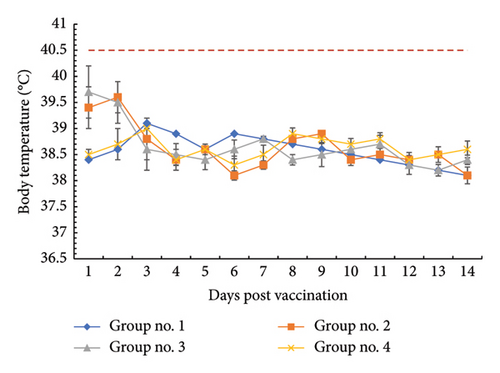
When assessing the hematological status, a tendency toward neutrophilic leukocytosis was revealed in all vaccinated animals: thus, the number of segmented neutrophils in groups no. 1, 2, and 3 increased by 1.6 (p < 0.05), 1.51 (p < 0.05) and 1.57 (p < 0.05) times respectively. There was also a significant increase in the number of monocytes by 2.3 times (p < 0.001) relative to the control group. No statistically significant changes in erythrocyte indices were detected.
When assessing the biochemical status of vaccinated animals, no changes in the profiles of the liver, kidney and heart were also observed. However, it was found that vaccinated animals demonstrated significantly higher levels of C-reactive protein: this indicator was recorded in animals of groups no. 2 and 3, subjected to increased vector load (a cocktail of monocistronic rAAV2 at a dosage of 5.6 × 1011 v.p. in group no. 2 and bicistronic rAAV2 at a dosage of 2.8 × 1011 v.p. in group no. 3). The distribution of the studied indicators is presented in Table 3.
| Parameter | Group no. | |||
|---|---|---|---|---|
| 1 | 2 | 3 | 4 | |
| Erythrocytes, 1012/L | 8.84 ± 0.42 | 8.97 ± 0.23 | 8.28 ± 0.32 | 9.44 ± 0.24 |
| Hemoglobin, g/L | 171.67 ± 5.12 | 161.67 ± 8.13 | 152.0 ± 4.64 ∗ | 180.67 ± 0.17 |
| Hematocrit, % | 49.97 ± 1.10 | 48.6 ± 0.62 | 49.53 ± 3.09 | 54.32 ± 2.34 |
| Mean corpuscular volume (MCV), fL | 55.42 ± 1.85 | 55.84 ± 1.6 | 58.43 ± 1.62 | 54.42 ± 2.12 |
| Mean concentration hemoglobin (MCH), pg | 18.0 ± 0 | 18.33 ± 0.41 | 18.67 ± 0.41 | 18.41 ± 0.27 |
| Mean corpuscular hemoglobin concentration (MCHC), g/L | 330.0 ± 4.24 | 315.0 ± 11.68 | 326.0 ± 4.9 | 312.45 ± 6.71 |
| RBC distribution, % | 14.53 ± 0.11 | 14.77 ± 0.23 | 14.2 ± 0.21 | 14.18 ± 0.17 |
| Leukocytes, ∗109/L | 11.67 ± 1.44 | 11.86 ± 0.27 | 12.22 ± 1.04 ∗ | 8.63 ± 0.34 |
| Blasts, % | 0 | 0 | 0 | 0 |
| Myelocytes, % | 0 | 0 | 0 | 0 |
| Metamyelocytes, % | 0 | 0 | 0 | 0 |
| Band neutrophils, % | 0 | 0 | 0 | 0 |
| Segmented neutrophils, % | 41.67 ± 2.27 ∗∗ | 39.33 ± 2.16 ∗∗ | 40.33 ± 1.47 ∗∗ | 29.05 ± 3.65 |
| Segmented neutrophils, 109/L | 4.68 ± 0,4 ∗ | 4.22 ± 0.37 ∗ | 4.9 ± 0.11 ∗∗ | 2.79 ± 0.34 |
| Eosinophils, % | 0 | 11.33 ± 0.82 | 8.67 ± 4.32 | 8.14 ± 2.67 |
| Eosinophils, 109/L | 0 | 1.26 ± 0.08 | 1.23 ± 0.12 | 1.74 ± 0.16 |
| Basophils, % | 0 | 0 | 0 | 0 |
| Monocytes, % | 3.0 ± 0.71 | 3.33 ± 0.82 | 7.67 ± 0.41 ∗∗∗ | 3.14 ± 0.25 |
| Monocytes, 109/L | 0.26 ± 0.08 | 0.38 ± 0.13 | 0.82 ± 0.08 ∗∗ | 0.33 ± 0.05 |
| Lymphocytes, % | 52 ± 5.66 | 42.67 ± 5.35 | 62.0 ± 2.55 | 68.47 ± 3.21 |
| Lymphocytes,109/L | 5.33 ± 0.42 | 5.67 ± 0.14 | 7.87 ± 0.44 | 5.98 ± 0.35 |
| Plasmocytes, % | 0 | 0 | 0 | 0 |
| Thrombocytes, 109/L | 390.67 ± 27.07 | 416.33 ± 20.7 | 391.33 ± 14.45 | 452.45 ± 36.76 |
| Mean platelet volume, fL | 11.03 ± 0.67 | 11.23 ± 0.35 | 11.17 ± 0.5 | 11.64 ± 0.54 |
| Reticulocytes, % | 1.97 ± 0.4 | 1.9 ± 0.28 | 2.23 ± 0.25 | 1.83 ± 0.21 |
| Normocytes, per 100 leukocytes | 0 | 0 | 0 | 0 |
| ESR, mm/h | 0.97 ± 0.11 | 1.07 ± 0.15 | 1.07 ± 0.15 | 1.02 ± 0.19 |
| C-reactive protein | Negative | Positive ∗ | Positive ∗ | Negative |
| Urea, mM/L | 5.27 ± 0.25 | 5.5 ± 0.44 | 4.63 ± 0.29 | 5.63 ± 0.23 |
| Creatinin, mcM/L | 125 ± 5.34 | 116.4 ± 0.64 | 128.67 ± 2.95 | 151.61 ± 3.6 |
| Total bilirubin, mcM/L | 3.8 ± 0.28 | 3.23 ± 0.43 | 2.37 ± 0.6 | 2.39 ± 0.21 |
| Direct bilirubin, mcM/L | 1 ± 0.18 | 0.8 ± 0.14 | 0.8 ± 0.25 | 0.96 ± 0.29 |
| Aspartat aminotransferase, U/L | 31.33 ± 0.58 | 39.03 ± 0.7 | 35.66 ± 2.11 | 34.43 ± 0.51 |
| Alanil aminotransferase, U/L | 38.16 ± 0.41 | 34.13 ± 0.43 | 36.63 ± 3.9 | 42.5 ± 0.26 |
| Alkaline phosphatase, U/L | 122.33 ± 4.6 | 103.66 ± 2.94 | 139 ± 3.93 | 127.45 ± 4.31 |
| Glucose, mM/L | 4.95 ± 0.19 | 4.99 ± 0.21 | 4.72 ± 0.17 | 5.71 ± 0.25 |
- Note: Variables of Significance (∗p ≤ 0.05, ∗∗p ≤ 0.01, ∗∗∗p ≤ 0.001).
3.3. Dynamics of Virus-Specific Antibodies Formation
Animals of all experimental groups responded to rAAV2 administration by producing virus-specific antibodies (Figure 2). 15 days dpv, animals from all three experimental groups had a doubtful serological status (inhibition coefficient from 30% to 40%), but by 30 dpv all animals became seropositive. An increase in antibody levels after boost vaccination was observed up to 60 dpv and slightly decreased by 180 dpv. The lowest endpoint antibody level was observed in group no. 1, the animals in which received a cocktail of monoconstructs at a total dosage of 2.8 × 1011 v.p.: the average inhibition coefficient in this group did not exceed 75%. In groups no. 2 and 3, the animals in which were subjected to increased vector load, this indicator varied between 89% and 91%; there were no significant differences in antibody levels between these groups.
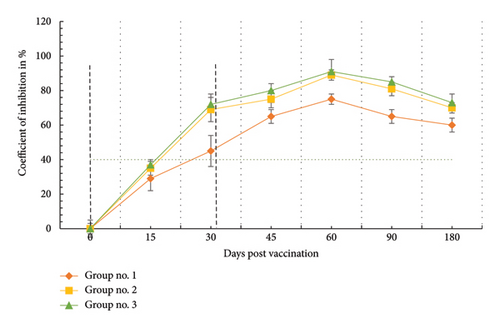
Additionally, we studied the dynamics of antibody formation for each of the expressed proteins separately (Figure 3). The results of ELISA with individual recombinant antigens revealed different levels of specific antibodies depending on the levels of expression of these antigens by various constructs.
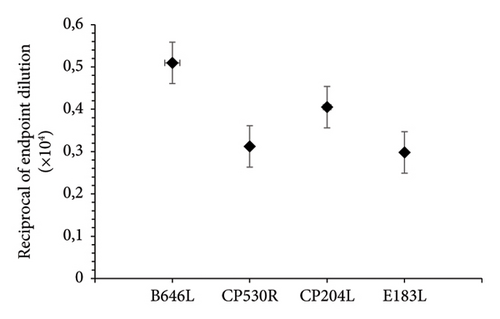
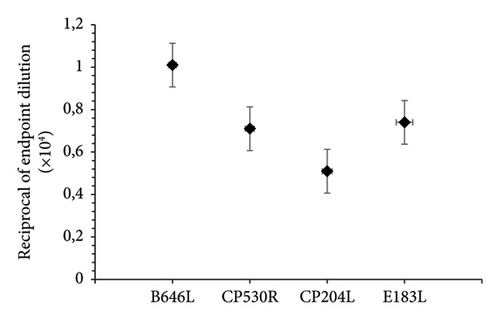
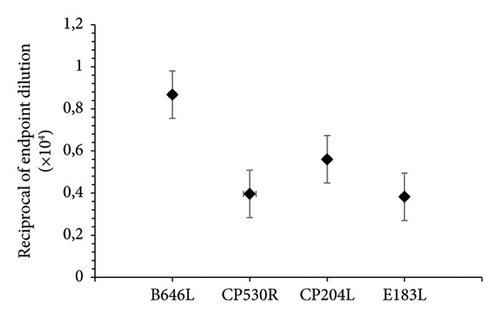
4. Discussion
It is known that initial research into the use of AAV for vaccine development was carried out using AAV serotype 2, which, despite the low transduction efficiency relative to other serotypes, induced the most powerful immune responses against the human immunodeficiency virus (HIV), the severe acquired respiratory syndrome coronavirus (SARS-CoV), and the human papillomavirus (HPV) [22, 23]. The choice of the introduction route of the AAV2-based genetic constructs was also dictated by the proven ability of the most effectively transgene expression a single dose of intramuscular injection [24, 25]. AAV2s are among the safest viral vectors in use, however the levels of humoral and cellular immune responses elicited by different doses in different animal species remain controversial [26]. Taking this into account, our first task was to assess the preliminary safety profile of a candidate vaccine based on AAV2 carrying the ASFV B646L, E183L, CP204L, and CP530R genes in different combinations. In the present study, we chose doses of 2.8 × 1011 v.p. and 5.6 × 1011 v.p. for a cocktail of monocistronic constructs and a dose of 2.8 × 1011 v.p. for a cocktail of bicistronic constructs containing pairwise combined genes B646L-E183L and CP530R-CP204L. It was found that prime and boost vaccination were satisfactorily tolerated by animals of all experimental groups. A postvaccination reaction at one to two dpv, including a moderate increase in temperature ((1.0 ± 0.2) °C), was observed in animals that received an increased vector load (groups no. 2 and 3). It should be noted that in preliminary studies we tested higher doses of rAAV2 (up to 11.2 × 1011 v.p. for a cocktail of monocistronic constructs), but in this case postvaccination reactions were more pronounced and included an increase in temperature to subfebrile at 12–14 dpv, as well as petechial skin rash that disappeared independently within 1–2 days. Such delayed effects may indicate an allergic reaction caused by the process of expression of target antigens, and therefore increased doses were not used in the main experiment. Satisfactory tolerability of rAAV2 is also evidenced by the absence of changes in the biochemical profiles of the kidney, heart and liver; an increase in C-reactive protein level in animals of some experimental groups, in our opinion, may be caused by a moderate proinflammatory reaction to viral capsids, which is known to be a characteristic of intramuscular administration [27]. Administered rAAV2 has been shown to stimulate both humoral and cellular immune responses. Today, there is strong evidence of the role of both components of the adaptive response in protection against ASF virus [28], which explains modern approaches to the design of recombinant vaccines [4]. In the present study, it was found that the highest concentration of antibodies (inhibition coefficient-89%–91%) is achieved at approximately 60 dpv when vaccinated with a cocktail of monocistronic constructs at a dose of 5.6 × 1011 v.p. and bicistronic constructs-at a dose of 2.8 × 1011 v.p. Due to the absence of significant differences between these two groups, it can be argued that coexpression of two or more antigens allows for a reduction in vector load, which is especially important when immunization with a pool of antigens is necessary. However, the specific mechanisms of ASF virus neutralization by antibodies remain a controversial issue that requires clarification [29]. However, in prospective, the final characterization of viral vectors can only be made after assessing cellular immunity.
5. Conclusions
This study contains data on a preliminary assessment of the safety and immunogenicity of mono- and bicistronic constructs based on AAV2 and immunodominant ASFV genes—B646L (p72), E183L (p54), CP204L (p30), and CP530R (pp60). During the studies, it was found that the proposed designs are safe and easily tolerated by animals and cause the induction of humoral and immune response, however, a comprehensive characterization of the AAV2-based vaccine candidate can be compiled after lethal infection. The determinants of the balance between tolerability and immunogenicity of AAV2 have not been fully studied, so further development of the topic lies in the area of optimizing the mechanism for delivering target genes to the cells of the host organism, as well as searching for additional conservative antigens, which will be especially relevant when designing an economical and effective vaccine for the regions, endemic for ASF and characterized by high genetic diversity of circulating strains.
Conflicts of Interest
The authors declare no conflicts of interest.
Funding
This study was funded by Russian Scientific Foundation (Grant No. 22-76-00013) «Evaluation of the effectiveness of a vector system based on adeno-associated virus for the delivery of genes encoding immunodominant proteins of the African swine fever virus into mammalian cells».
Open Research
Data Availability Statement
The data used and/or analyzed in this study are available from the corresponding author upon reasonable request.




